Saludos al equipo de #Hive y comunidad Amazing Nature. He estado disfrutando de la hermosa naturaleza del país donde vivo ahora.
Argentina es un cúmulo de sorpresas gratas, por su gente amable y cariñosa, así como también por la exótica y variada vegetación que posee. Cada día me impresiona más gran la variedad de flores que exhiben sus rincones, aceras, jardines y plazas.
Para esta publicación, he elegido tres especies diferentes. Explicaré mi visión, algunas investigaciones hechas para poder describir cada flor, y luego colocaré la taxonomía de cada una, con su respectiva fuente.
Greetings to the #Hive team and Amazing Nature community. I have been enjoying the beautiful nature of the country where I live now.
Argentina is an accumulation of pleasant surprises, for its kind and loving people, as well as for the exotic and varied vegetation it possesses. Every day I am more and more impressed by the variety of flowers in its corners, sidewalks, gardens and squares.
For this publication, I have chosen three different species. I will explain my vision, some research done to describe each flower, and then I will post the taxonomy of each one, with its respective source.
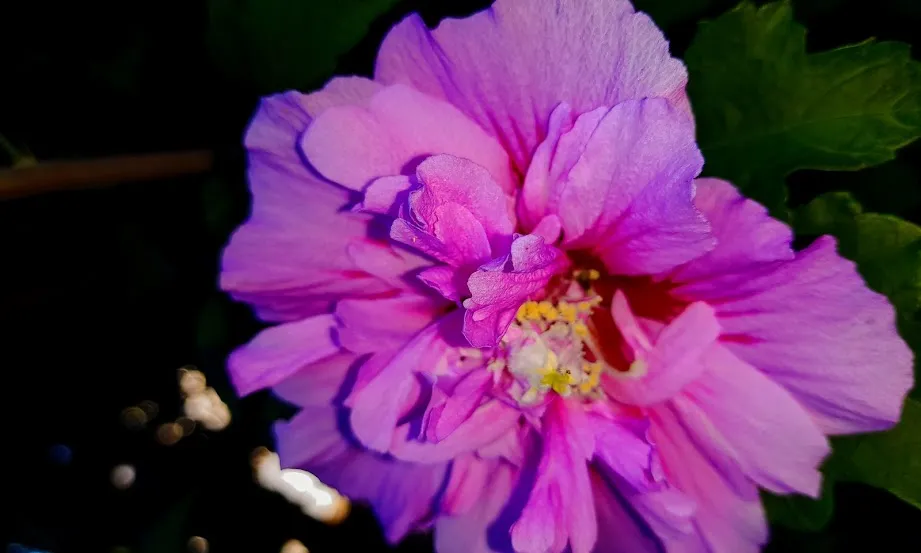
A medida que avanzaba, no podía creer lo que veían mis ojos. Era un arbusto como de dos metros, repleto de unas "rosas" color rosado. Confieso que no recuerdo haberla visto nunca. Lo que sí noté fue que tenía cierta similitud con una flor que en mi país Venezuela llamamos Cayena rizada. Aunque cuando estaba leyendo acerca de la especie, nada tiene que ver con ella, ni con las rosas.
Es una hermosa flor cuya especie es llamada Hisbiccus syriacus. Es muy parecida a la Cayena Risada, que abunda en mi país Venezuela. Casualmente, pertenecen al mismo orden de las Malváceas. Es un arbusto que cuando es verano florece durante los veranos cálidos y hasta la llegada del otoño. El tiempo de vida de una flor es de un día, pero no se nota porque se reproducen en mucha cantidad como se observa en la siguiente imagen. Esta especie posee una gran variedad de colores: blancos, fucsia, rosadas y rojas, entre otros. Realmente me encantó tanto el arbusto. Como la gran cantidad de flores que luce.
As I advanced, I could not believe my eyes. It was a bush about two meters high, full of pink "roses". I confess that I don't remember ever having seen it before. What I did notice was that it had a certain similarity with a flower that in my country Venezuela we call Cayena curly. Although when I was reading about the species, it has nothing to do with it, nor with roses. It is a beautiful flower whose species is called Hisbiccus syriacus. It is very similar to the Cayenne Risada, which is abundant in my country Venezuela. Coincidentally, they belong to the same order of the Malvaceae. It is a shrub that when it is summer blooms during the hot summers and until the arrival of autumn. The life time of a flower is one day, but it is not noticed because they reproduce in great quantity as it is observed in the following image. This species has a great variety of colors: white, fuchsia, pink and red, among others. I really loved both the bush. As the great quantity of flowers that it shows.

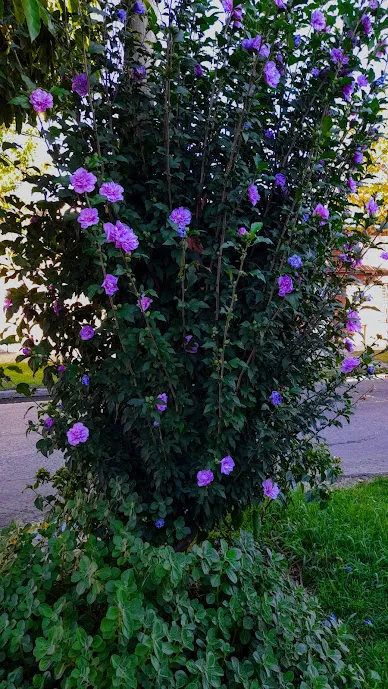
TAXONOMIA
Reino: Plantae
División: Magnoliophyta
Clase: Magnoliopsida
Subclase: Dilleniidae
Orden: Malvales
Familia: Malvaceae
Subfamilia: Malvoideae
Tribu: Hibisceae
Género: Hibiscus
Especie: Hibiscus syriacus
L.
Fuente
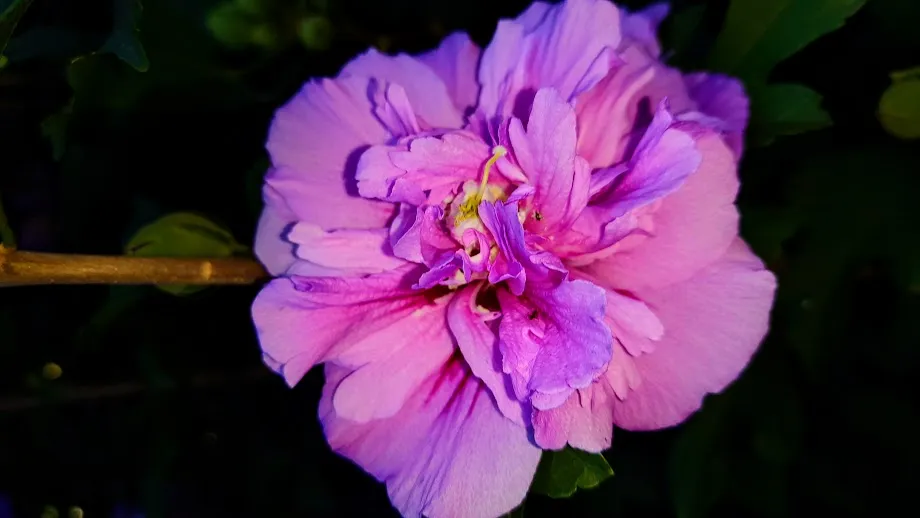
Quisiera que jamás dejase de florecer, porque es una planta obnubilante, Quien la observa de cerca, se va a encantar con ella. Yo afortunadamente la tengo muy cerca de casa. Está sembrada en una acera. Para que todo aquel que pase, le provoque tomarle fotos como lo hice yo.
I would like it to never stop flowering, because it is a dazzling plant, whoever looks at it closely, will be enchanted by it. Fortunately I have it near my house. It is planted on a sidewalk. So that everyone who passes by, will be provoked to take pictures of it as I did.
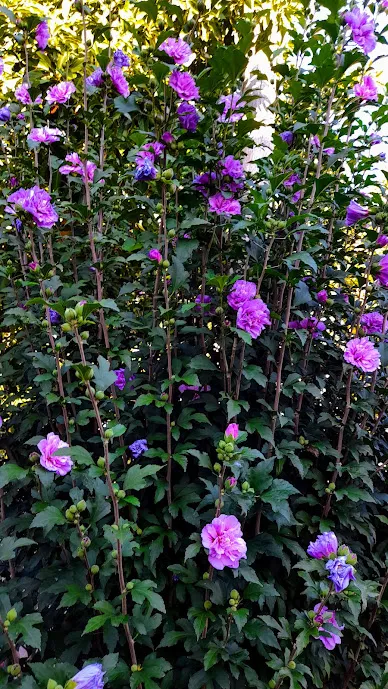


Este singular ramillete de pequeñas flores amarillas, me encandiló al contemplar esos tonos tan amarillos que parecen estar hechos con rayos de sol. Ciertamente, deben recibir sus reflejos, para poder mantenerse con vida. Me trajo recuerdos de mi país Venezuela, porque allá las tenemos en muchas tonalidades y las llamamos "Cariaquito", indistintamente. Muchas personas tienen costumbres ancestrales y creen mucho en la energía que las plantas proyectan en el cuerpo. Utilizan una en especial cuya flor es de color morado, para preparar baños con ellas. Dicen que les atrae la buena suerte. Me voy a tomar la libertad de recomendarles una publicación realizada por @aliramonrierato, en Febrero de 2021, donde explica magistralmente acerca del tema "Cariaquito Morado"
This unique bouquet of small yellow flowers, dazzled me when I contemplated such yellow tones that seem to be made with rays of sunlight. Certainly they must receive their reflections in order to stay alive. It brought back memories of my country Venezuela, because there we have them in many shades and we call them "Cariaquito", indistinctly. Many people have ancestral customs and believe in the energy that plants project in the body. They use one in particular, whose flower is purple, to prepare baths with them. I am going to take the liberty of recommending a publication made by @aliramonrierato, in February 2021, where she masterfully explains about the subject "Cariaquito Morado".
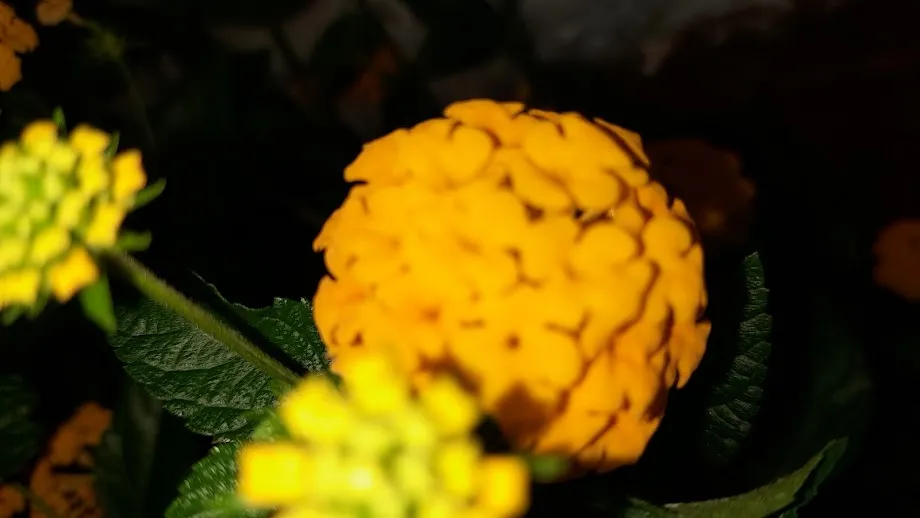
Esta planta no requiere de muchos cuidados, es fuerte, pero aun así, debe recibir mucho sol, no se debe regar en exceso porque sus raíces se ablandan y muere. Es originaria de América debido a que su clima es tropical. Se puede mantener en macetas. Algunas son capaces de cambiar el color de sus flores, luego de culminar un ciclo de floración. Las que son blancas en el centro, pueden llegar a tener en los bordes un color más intenso como naranja o rojo. Realmente son un gran espectáculo multicolor. No son para climas de invierno; sin embargo, son capaces de mantenerse bajo sombra. Estas en particular, las descubrí en el jardín de una casa, durante mi paseo hacia la ciudad. Pedí permiso para tomar fotos, pues me fascinó semejante belleza.
This plant does not require a lot of care, it is strong, but even so, it must receive a lot of sun, it should not be watered excessively because its roots become soft and it dies. It is native to America because its climate is tropical. It can be kept in pots. Some are able to change the color of their flowers, after completing a flowering cycle. Those that are white in the center, can have a more intense color like orange or red on the edges. They are really a great multicolored spectacle. They are not for winter climates, however they are capable of being kept in shade. These in particular, I discovered them in the garden of a house, during my walk to the city. I asked permission to take pictures, as I was fascinated by such beauty.
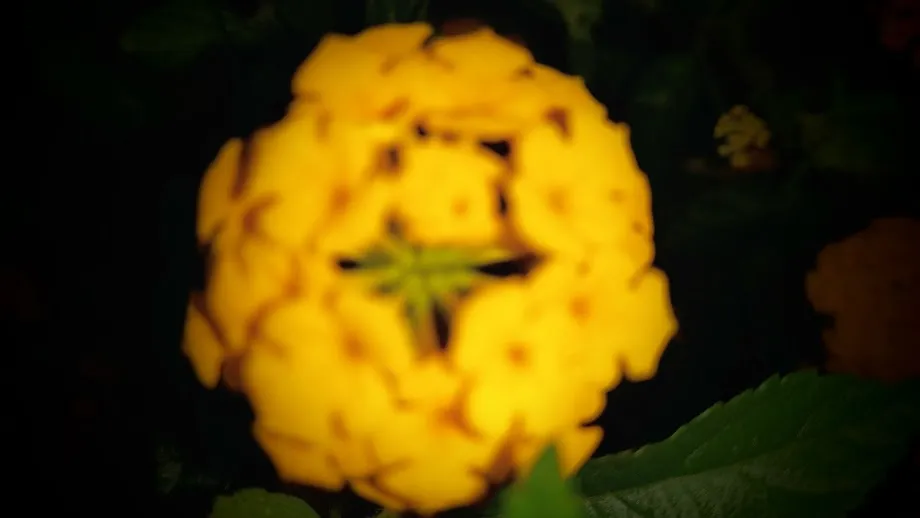
TAXONOMIA
Reino: Plantae
División: Magnoliophyta
Clase: Magnoliopsida
Subclase: Asteridae
Orden: Lamiales
Familia: Verbenaceae
Género: Lantana
Especie: Lantana camara
L. (1753)
Fuente
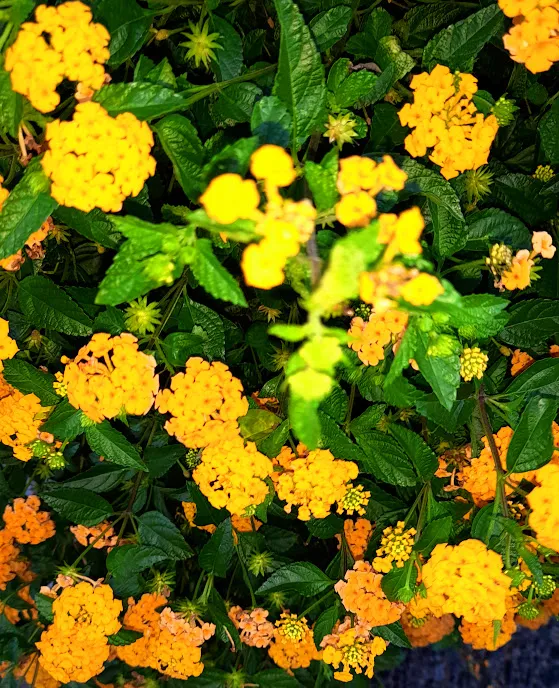

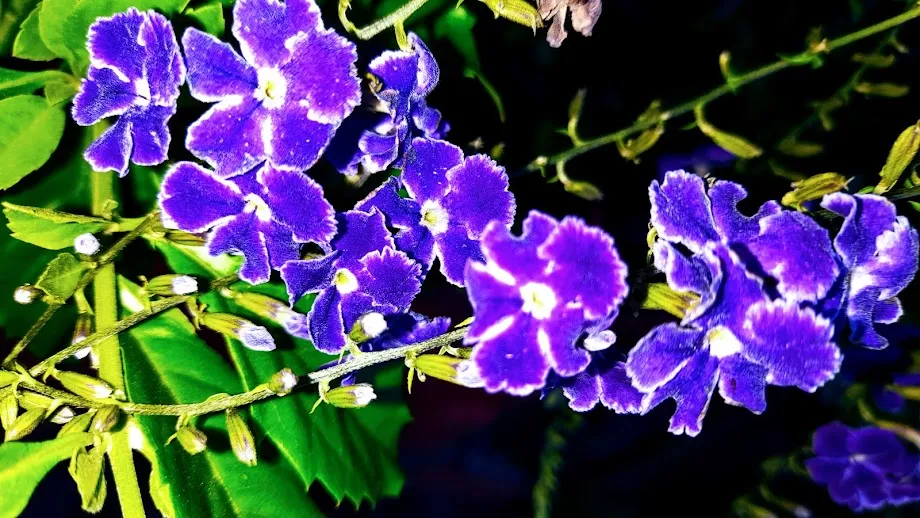
Y por último pero no menos importante, les muestro estas hermosas florecitas (pues son muy pequeñitas), que me sorprendieron gratamente cuando regresaba a casa por otra vereda. Las descubrí en un tupido jardín. Se nota que están muy bien protegidas porque tienen cámaras en ese lugar y no logré respuesta para solicitar el debido permiso. Sin embargo, tomé algunas fotos desde afuera con cierto recelo.
Esta Violeta en ramas, llamadas así por su parecido con las violetas de maceta cuyo color es similar, o Duranta erecta de acuerdo a su especie, se desarrollan en un arbusto que podría llegar a crecer hasta unos 4 mt. Sus flores se desarrollan en formas paniculares,es decir en racimos y su fruto es una baya también en racimos y Jugosa, (tal vez tóxica para el humano). No pude hacer tomas del fruto pues no se observaron del lado de afuera, por lo cual les recomiendo buscar en el siguiente Enlace
And last but not least, I show you these beautiful little flowers (they are very tiny), which pleasantly surprised me when I was returning home on another sidewalk .Las discovered them in a dense garden. You can tell they are very well protected because they have cameras in that place and I did not get an answer to ask for permission. However, I took some photos from outside with some misgivings.
This Violet on branches, so called because of its resemblance to the potted violets whose color is similar, or Duranta erecta according to their species, develop in a bush that could grow up to 4 mt. Its flowers develop in panicular forms, that is to say in clusters and its fruit is a berry also in clusters and juicy, (perhaps toxic to humans). I could not take pictures of the fruit because they were not observed from the outside, so I recommend you to look in the following Link
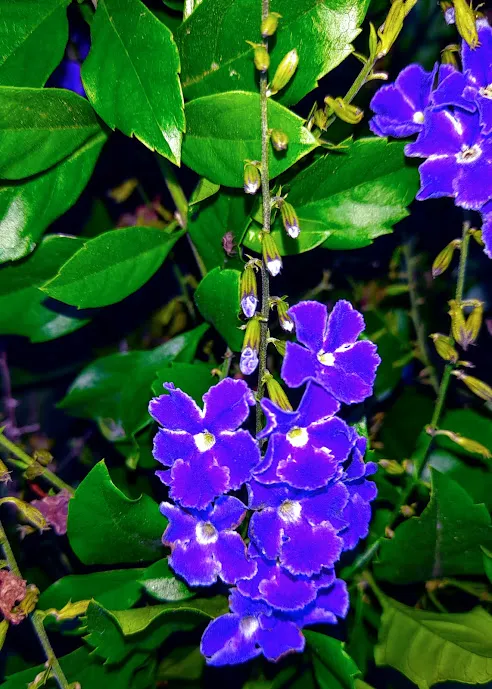
La Duranta erecta tiene unas púas que la caracterizan como "Duranta", (Llamado así a todo arbusto espinoso) y se pueden observar en sus ramajes. También requiere de mucha luz del sol para mantenerse hermosa y saludable. Ella se podría colgar en macetas, siempre y cuando se pode frecuentemente para que se mantenga su floración y tamaño. Es recomendada para los balcones y ventanales. Asimismo, la siembran en los parques debido a su belleza y elegancia. Además, en esos espacios la Duranta se expande y se podrá disfrutar de su pleno desarrollo y adornar esos lugares para la recreación. Siempre dando las recomendaciones de cuidar esos espacios que serán la herencia del futuro.
This plant has spikes that characterize it as a "Duranta", (so called to any thorny shrub) and can be seen on its branches. It also requires a lot of sunlight to stay beautiful and healthy. She could be hung in pots, as long as it is pruned frequently to maintain its flowering and size. It is recommended for balconies and windows. It is also planted in parks because of its beauty and elegance. In addition, in these spaces Duranta expands and you can enjoy its full development and decorate these places for recreation. Always giving the recommendations to take care of those spaces that will be the inheritance of the future.
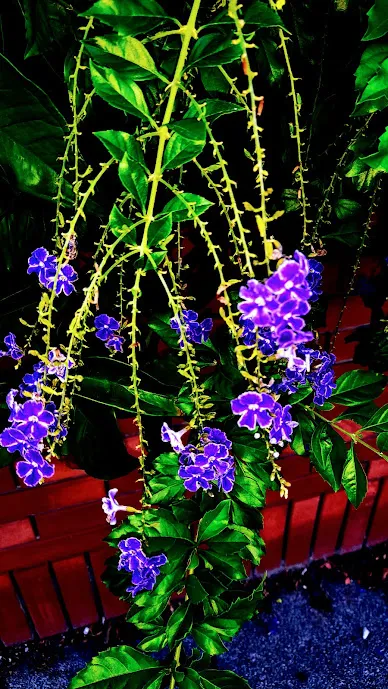
TAXONOMIA
Reino: Plantae
Subreino: Tracheobionta
(sin rango): Eudicotas
Clase: Magnoliopsida
Subclase: Asteridae
(sin rango): Astéridas
Orden: Lamiales
Familia: Verbenaceae
Género: Duranta
Especie: Duranta erecta
Fuente
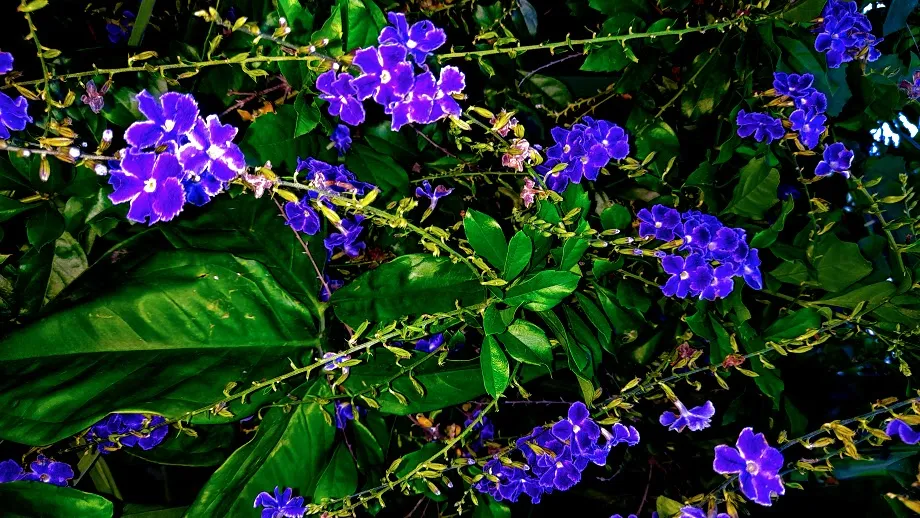

Separadores
Estoy muy agradecida por vuestra visita a mi publicación.
Twitter: nuher001I am very grateful for your visit to my publication.
Twitter: nuher001
Editor
Traductor
Fotografías: tomadas con mi celular Samsung A-12
Consultas, N° 1, N° 2, N° 3 y N° 4.